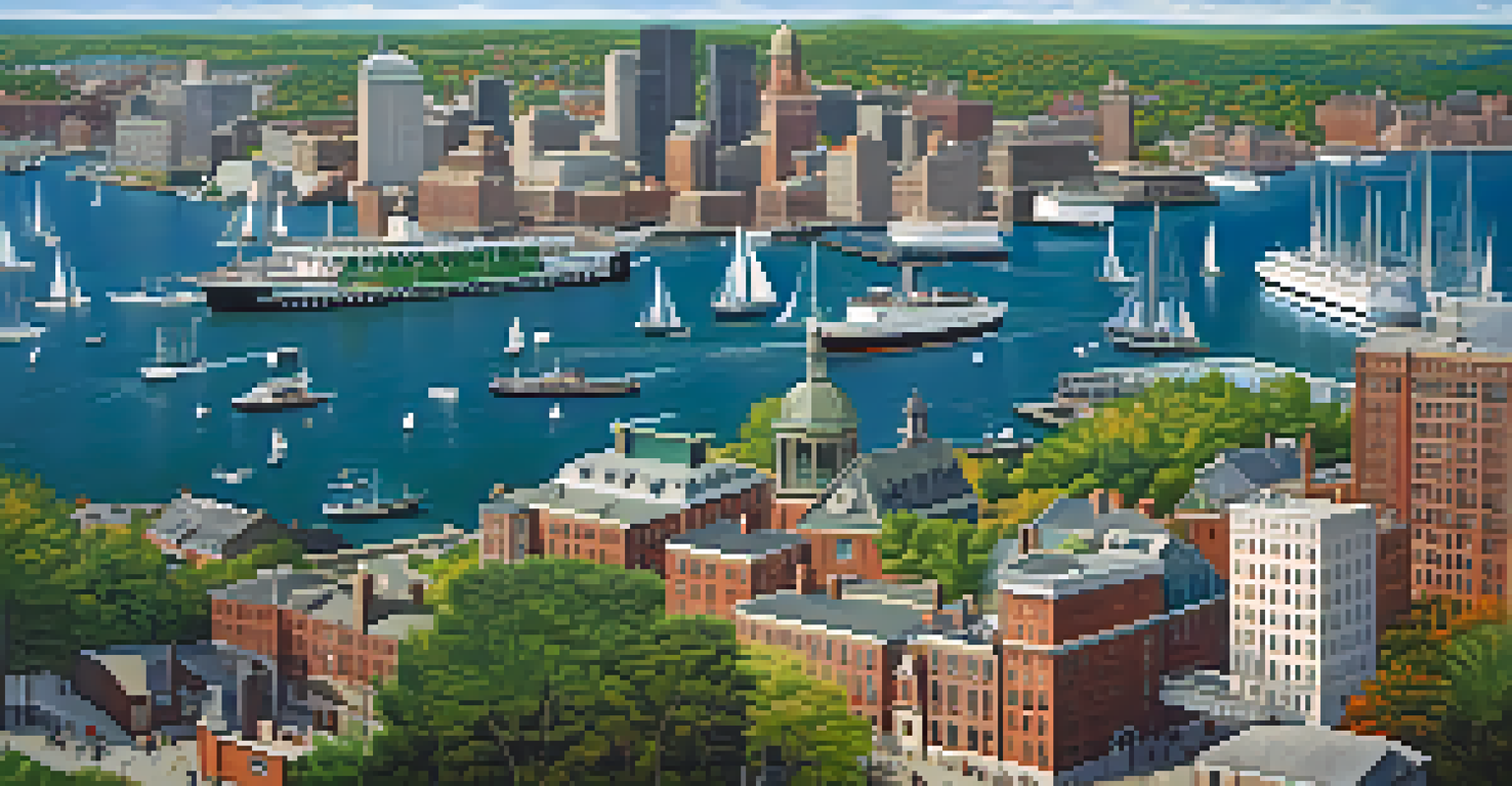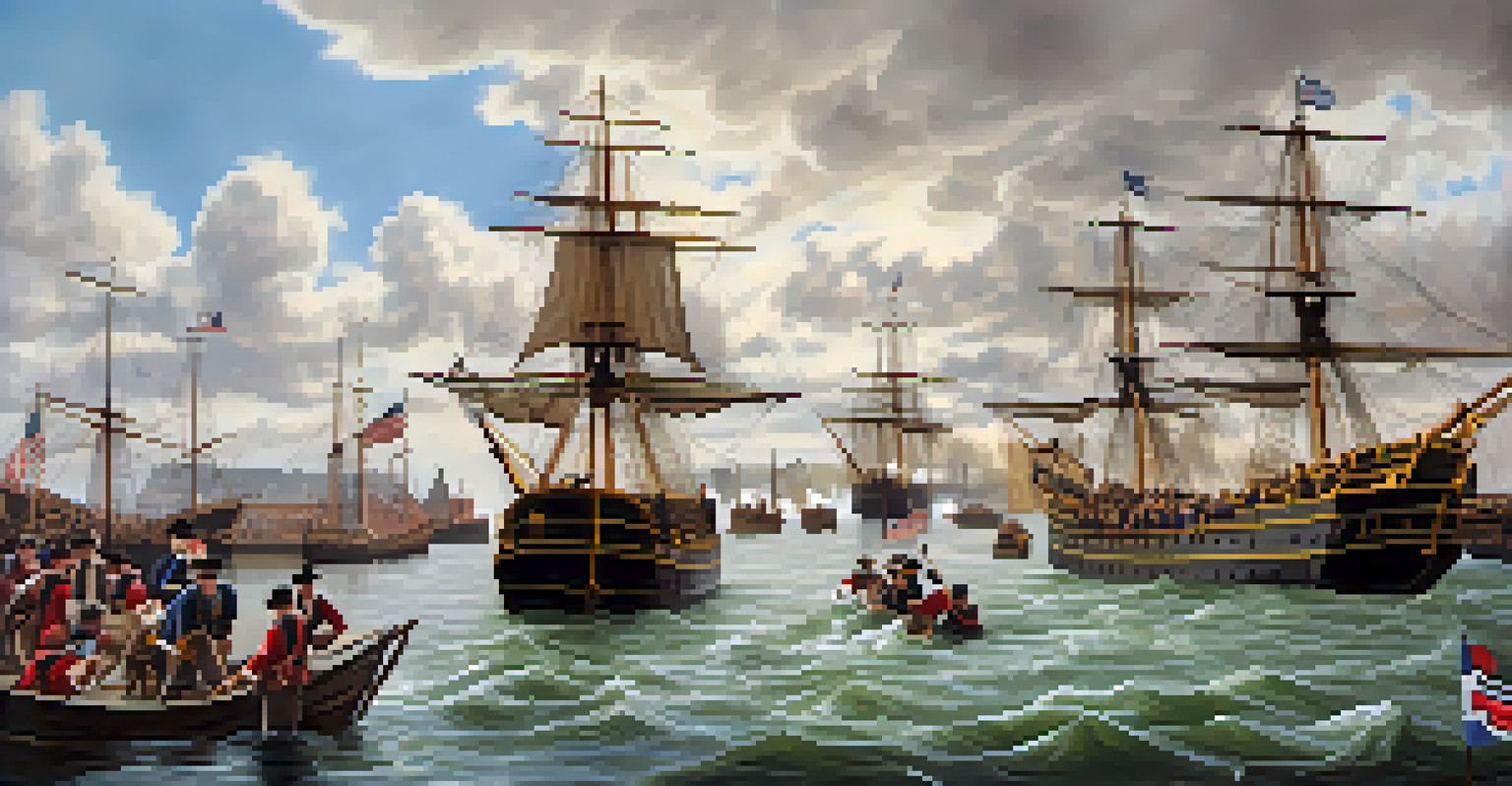The Boston Harbor: Gateway to Colonial Trade and Revolution

Historical Significance of Boston Harbor in Colonial Trade
Boston Harbor has long been recognized as a pivotal point for colonial trade. Established in the 17th century, it served as a bustling port where ships would exchange goods from Europe and the Caribbean. The harbor's strategic location made it an ideal gateway for importing essential supplies and exporting local products, such as fish and rum.
Boston Harbor was the stage for a defining moment in American history, where the struggle for liberty was ignited.
As trade flourished, Boston emerged as a commercial powerhouse, allowing merchants to accumulate wealth and influence. This economic prosperity fostered a sense of identity among the colonists, as they began to view themselves as part of a larger, interconnected world. The harbor wasn't just a physical space; it became a symbol of opportunity and growth for the colonies.
However, the growing trade also attracted the attention of British authorities, leading to increased regulations and taxes. Tensions rose between the colonists and the Crown, setting the stage for future conflicts. Thus, Boston Harbor became not only a center of commerce but also a catalyst for revolutionary ideas.
The Role of Boston Harbor in the American Revolution
As discontent mounted, Boston Harbor transformed into a hotbed of revolutionary activity. It was here that the infamous Boston Tea Party took place in 1773, a direct protest against British taxation without representation. Colonists disguised as Native Americans dumped an entire shipment of tea into the harbor, signaling their refusal to accept oppressive measures.

This act of defiance galvanized support among the colonists and drew attention to their plight. The harbor became a gathering point for revolutionaries who were determined to challenge British authority. It was not just about tea; it represented a broader struggle for freedom and self-governance.
Boston Harbor: Trade Powerhouse
In the 17th century, Boston Harbor became a vital port for colonial trade, facilitating economic growth and shaping the identity of the colonies.
Following the Boston Tea Party, British troops were sent to restore order, leading to further confrontations. The harbor's waters were stained not just with tea, but with the fervor of a populace ready to fight for their rights. Boston Harbor thus became a significant backdrop for the revolutionary fervor that would sweep across the colonies.
Key Events at Boston Harbor That Shaped American History
Several key events unfolded in and around Boston Harbor that played a crucial role in shaping American history. The Boston Massacre in 1770, where British soldiers shot and killed several colonists, heightened tensions and transformed public sentiment against British rule. This tragic incident was a turning point that fueled revolutionary fervor.
Immigrants brought their hopes and dreams through the gates of Boston Harbor, enriching the fabric of America.
In addition to the Massacre, the harbor served as the site of numerous meetings and gatherings for revolutionary leaders. Figures like Samuel Adams and John Hancock rallied support for independence, using the harbor as a backdrop for their calls to action. The harbor was not just a physical space; it was a stage for ideas that would eventually lead to the birth of a nation.
These events solidified Boston Harbor's status as a symbol of resistance and resilience. It became a reminder of what was at stake, urging colonists to unite against oppression. The harbor's waters were deeply intertwined with the struggle for liberty, marking its place in the annals of history.
Boston Harbor: A Hub for Immigrant Arrival and Cultural Exchange
Beyond trade and revolution, Boston Harbor has been a gateway for countless immigrants seeking new opportunities. Throughout the 19th and early 20th centuries, waves of immigrants arrived at this bustling port, bringing diverse cultures and traditions to New England. The harbor became a melting pot where different communities could blend and thrive.
As immigrants settled in Boston, they contributed to the city’s economy, making it a vibrant cultural hub. Italian, Irish, and Jewish communities, among others, established neighborhoods that celebrated their unique heritages while also contributing to the American identity. This cultural exchange enriched the fabric of the city and left a lasting legacy.
Catalyst for American Revolution
Key events like the Boston Tea Party transformed Boston Harbor into a center of revolutionary activity, symbolizing the colonists' fight for freedom.
Today, the stories of those who arrived through Boston Harbor continue to shape the city's identity. The harbor stands as a testament to the American Dream, illustrating how hope and determination can lead to a brighter future. It remains a symbol of resilience for all who seek a better life.
The Modern Significance of Boston Harbor
In contemporary times, Boston Harbor remains a vital economic and cultural asset. It serves as a major port for shipping and trade, supporting local businesses and contributing to the region's economy. The harbor is not only a hub for goods but also a place for tourism, drawing visitors to its historic sites and scenic views.
Moreover, the harbor is a focal point for environmental initiatives aimed at preserving its natural beauty and ecosystem. Efforts to clean up the waters and restore coastal habitats highlight the ongoing commitment to sustainability. This modern-day stewardship reflects the values of the community, prioritizing both economic growth and environmental health.
As Boston Harbor continues to evolve, it stands as a reminder of the city's rich history while embracing a sustainable future. The harbor, once a battleground for revolution, now serves as a beacon of hope and progress for generations to come.
Tourist Attractions and Historical Sites Around Boston Harbor
Visitors to Boston Harbor can explore a plethora of historical sites that tell the story of its significance. The Boston Tea Party Ships & Museum offers an interactive experience, allowing guests to relive the events of that fateful night in 1773. It’s a fun and educational way to connect with history while enjoying the vibrant atmosphere of the harbor.
Another must-visit site is the Boston National Historical Park, which encompasses several key locations, including the Old North Church and the Bunker Hill Monument. These sites serve as reminders of the sacrifices made by those who fought for independence, providing a deeper understanding of the revolutionary spirit that characterized the era.
Cultural Gateway for Immigrants
Throughout the 19th and early 20th centuries, Boston Harbor welcomed waves of immigrants, enriching the city's cultural landscape and contributing to the American identity.
Additionally, taking a stroll along the waterfront or hopping on a harbor cruise allows visitors to appreciate the stunning views of the skyline and the harbor itself. Whether you’re a history buff or just looking for a picturesque day out, Boston Harbor has something for everyone.
The Future of Boston Harbor: Challenges and Opportunities
As we look to the future, Boston Harbor faces a mix of challenges and opportunities. Issues such as climate change and rising sea levels pose significant threats to the waterfront and surrounding communities. Local leaders are actively seeking solutions to mitigate these impacts, ensuring that the harbor remains a safe and viable space for generations to come.
At the same time, there are exciting developments on the horizon. Plans for revitalizing the waterfront area aim to enhance public access and recreational opportunities. This vision of a more vibrant harbor includes parks, walking paths, and spaces for community gatherings, fostering a sense of connection among residents and visitors alike.

Ultimately, the future of Boston Harbor lies in balancing preservation with progress. By addressing environmental concerns and promoting community engagement, the harbor can continue to thrive as a historic and economic asset. As it evolves, it will remain a symbol of the spirit that has defined Boston for centuries.